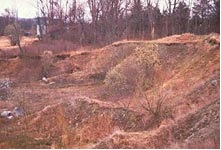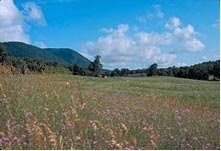Land Reclamation
Description
Land reclamation is a management practice that is usually associated with resource extraction. It is the process of returning damaged land to its original condition or to an acceptable condition through land smoothing and/or critical area planting. Steep slopes and high walls are usually taken down to a stable grade for safety and drainage. In addition, missing or poorly functional natural resources are often restored to a condition that is consistent with the surrounding area. This may include the application of topsoil, vegetation, proper drainage, and landscaping practices.
The land reclamation process should include a Document of Reclamation. This determines the timelines and effectiveness of the reclamation process as well as other site-specific concerns. It is most commonly applied at the beginning of a development process to ensure the final land use is appropriate and is in accordance with town requirements (USEPA, 2002).
Applicability
Land reclamation is applicable to all mining or similar activities where land features and natural resources are disrupted (although it is most commonly implemented on land that is 2 acres or larger in size). Although it is typically applied to areas that have been "mined out", land reclamation should not be limited to mining properties. Land reclamation can be applied to any property with degraded natural conditions that may be permanently improved through actions that adjust topography and drainage, establish vegetation for erosion control and habitat, and protect surface and ground water resources (USEPA, 2002).
Local Regulation
Land reclamation activities can be best regulated by municipalities though adoption of a specific non-zoning bylaw. A Massachusetts example of a non-zoning bylaw for earth/gravel removal can be found at:
http://www.umass.edu/masscptc/bylaws/EarthRem_CC.html
 The Bartholomew Farmland Preserve (Sheffield, MA) was once mined for gravel, leaving the farmlands stripped of vegetation. (photo from The Nature Conservancy)
The Bartholomew Farmland Preserve (Sheffield, MA) was once mined for gravel, leaving the farmlands stripped of vegetation. (photo from The Nature Conservancy)
|
 In 1999, after restoration efforts by the Nature Conservancy, the mined lands were restored to their original beauty. (photo from The Nature Conservancy)
In 1999, after restoration efforts by the Nature Conservancy, the mined lands were restored to their original beauty. (photo from The Nature Conservancy)
|
Cost
Pre-planning and incorporating land reclamation with the mining process can significantly lower the cost, especially when mining in rural locations (USEPA, 2002).
Maintenance
Maintenance of restored land is dependent on the area and the land use. It is recommended that the area be visited regularly to inspect erosion and sediment control measures and to repair failing areas.
References
USEPA. 2002.
Best Management Practices to Reduce Non-Point Source Pollution in the Town of Plainfield, Connecticut. American Groundwater Trust. Boston, MA.
Recommended Fact Sheets and Resources
CCCMBR Bylaws and Regulations: Model Land Clearing, Grading and Protection of Specimen Tree Bylaw. Cape Cod Commission.
Hairston, J. E. and L. Stribling. 1995.
The Rural Environment and NPS Pollution: Controlling Agriculture NPS Pollution Through Best Management Practices. wq-423.al. Auburn University - Alabama Corporative Extension Service.
http://hsermes.ecn.purdue.edu:8001/cgi/convertwq?7776
LSU. 2002.
Sugarcane Best Management Practices. Code 466. AgCenter - Research and Extension.
http://www.agctr.lsu.edu/subjects/bmp/sugarcane/soilmanagement8.asp
MDEP. 1994.
Massachusetts NonPoint Source Management Manual "The Megamanual": A Guidance Document for Municipal Officials. 17356-500-500-6/93-67.00. Office of Watershed Management: Nonpoint Source Program. Boston, MA.
NRCS. 2002.
Conservation Practice Standard: Land Smoothing. Code 466. Natural Resource Conservation Service.
USDI. The Office of Surface Mining. Accessed August 16, 2002.
http://www.osmre.gov